Related Research Articles
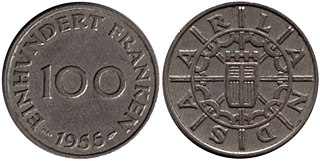
The franc is any of various units of currency. One franc is typically divided into 100 centimes. The name is said to derive from the Latin inscription francorum rex used on early French coins and until the 18th century, or from the French franc, meaning "frank".
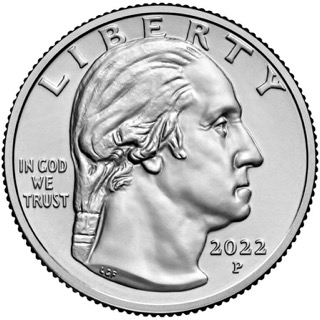
The quarter, short for quarter dollar, is a United States coin worth 25 cents, one-quarter of a dollar. The coin sports the profile of George Washington on its obverse, and after 1998 its reverse design has changed frequently. It has been produced on and off since 1796 and consistently since 1831.
Coins of the United States dollar were first minted in 1792. New coins have been produced annually and they make up a valuable aspect of the United States currency system. Today, circulating coins exist in denominations of 1¢, 5¢, 10¢, 25¢, 50¢, and $1.00. Also minted are bullion and commemorative coins. All of these are produced by the United States Mint. The coins are then sold to Federal Reserve Banks which in turn are responsible for putting coins into circulation and withdrawing them as demanded by the country's economy.
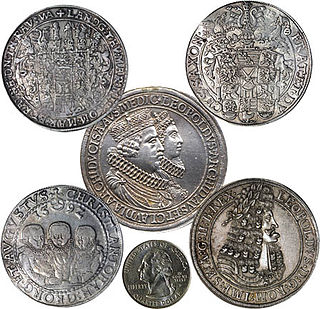
A thaler or taler is one of the large silver coins minted in the states and territories of the Holy Roman Empire and the Habsburg monarchy during the Early Modern period. A thaler size silver coin has a diameter of about 40 mm and a weight of about 25 to 30 grams. The word is shortened from Joachimsthaler, the original thaler coin minted in Joachimstal, Bohemia, from 1520.

The Napoléon is the colloquial term for a former French gold coin. The coins were minted in denominations of 5, 10, 20, 40, 50, and 100 francs. This article focuses on the 20 franc coins issued during the reign of Napoléon Bonaparte, which are 21 mm in diameter, weigh 6.45 grams and, at 90% pure, contain 0.1867 troy ounces (5.807 g) of pure gold. The coin was issued during the reign of Napoleon I and features his portrait on the obverse. The denomination continued in use through the 19th century and later French gold coins in the same denomination were generally referred to as "Napoléons". Earlier French gold coins are referred to as Louis or écu. Gold Napoléons have historically proven more resilient than other gold coins to economic forces, such as after the Suez crisis when unlike other coins Napoléons did not weaken.

The Dahlonega Mint was a former branch of the United States Mint built during the Georgia Gold Rush to help the miners get their gold assayed and minted, without having to travel to the Philadelphia Mint. It was located at in Dahlonega, Lumpkin County, Georgia. Coins produced at the Dahlonega Mint bear the "D" mint mark. That mint mark is used today by the Denver Mint, which opened in 1906, over four decades after the Dahlonega Mint closed. All coins from the Dahlonega Mint are gold, in the $1, $2.50, $3, and $5 denominations, and bear dates in the range 1838–1861.

The Royal Mint is the United Kingdom's oldest company and the official maker of British coins.

The United States Mint is a bureau of the Department of the Treasury responsible for producing coinage for the United States to conduct its trade and commerce, as well as controlling the movement of bullion. It does not produce paper money; that responsibility belongs to the Bureau of Engraving and Printing. The first United States Mint was created in Philadelphia in 1792, and soon joined by other centers, whose coins were identified by their own mint marks. There are currently four active coin-producing mints: Philadelphia, Denver, San Francisco, and West Point.

The Royal Canadian Mint is the mint of Canada and a Crown corporation, operating under the Royal Canadian Mint Act. The shares of the Mint are held in trust for the Crown in right of Canada.
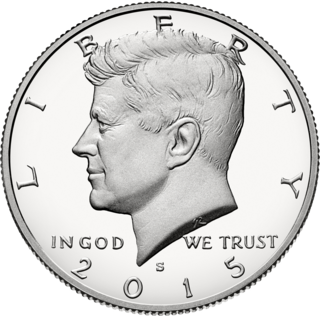
The half dollar, sometimes referred to as the half for short or 50-cent piece, is a United States coin worth 50 cents, or one half of a dollar. In both size and weight, it is the largest United States circulating coin currently produced, being 1.205 inches in diameter and 0.085 in (2.16 mm) in thickness, and is twice the weight of the quarter. The coin's design has undergone a number of changes throughout its history. Since 1964, the half dollar depicts the profile of President John F. Kennedy on the obverse and the seal of the president of the United States on the reverse.
A mint is an industrial facility which manufactures coins that can be used as currency.

The solidus or nomisma was a highly pure gold coin issued in the Late Roman Empire and Byzantine Empire. The early 4th century saw the solidus introduced in mintage as a successor to the aureus, which was permanently replaced thereafter by the new coin, whose weight of about 4.5 grams remained relatively constant for seven centuries. In the Byzantine Empire, the solidus, or nomisma, remained a highly pure gold coin until the 11th century, when several Byzantine emperors began to strike the coin with less and less gold. The nomisma was finally abolished by Alexius I in 1092, who replaced it with the hyperpyron, which also came to be known as a "bezant". The Byzantine solidus also inspired the originally slightly less pure dinar issued by the Muslim Caliphate. In Western Europe, the solidus was the main gold coin of commerce from late Roman times to Pepin the Short's currency reform in the 750s, which introduced the silver-based pound/shilling/penny system.
Assay offices are institutions set up to assay precious metals. This is often done to protect consumers from buying fake items. Upon successful completion of an assay the assay offices typically stamp a hallmark on the item to certify its metallurgical content. Hallmarking first appeared in France, with the Goldsmiths' Statute of 1260 promulgated under Étienne Boileau, Provost of Paris, for King Louis IX.

The Canadian fifty-cent coin is a Canadian coin worth 50 cents. The coin's reverse depicts the coat of arms of Canada. At the opening ceremonies for the Ottawa branch of the Royal Mint, held on January 2, 1908, Governor General Earl Grey struck the Dominion of Canada's first domestically produced coin. It was a silver fifty-cent coin bearing the effigy of King Edward VII.

The New Orleans Mint operated in New Orleans, Louisiana, as a branch mint of the United States Mint from 1838 to 1861 and from 1879 to 1909. During its years of operation, it produced over 427 million gold and silver coins of nearly every American denomination, with a total face value of over US$ 307 million. It was closed during most of the American Civil War and Reconstruction.

Vreneli is the informal name for a range of legal tender gold coins of the Swiss franc. The coins were issued between 1897 and 1936, in 1947 and in 1949. All coins issued after 1936 are restrikes.
A mint mark is a letter, symbol or an inscription on a coin indicating the mint where the coin was produced. It should not be confused with a mintmaster mark which is the mark of the mintmaster.
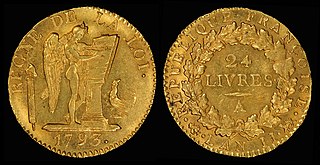
The livre was the currency of Kingdom of France and its predecessor states of Francia and West Francia from 781 to 1794. Several different livres existed, some concurrently. The livre was the name of coins and of units of account.

Canada has an extensive history with regard to its currencies. Prior to European contact, indigenous peoples in Canada used items such as wampum and furs for trading purposes, which continued when trade with Europeans began.
References
- ↑ All About Mintmarks
- ↑ Swissmint Archived May 13, 2007, at the Wayback Machine